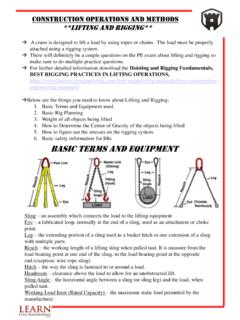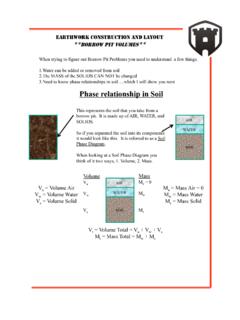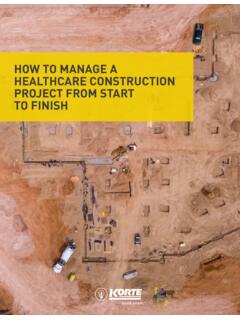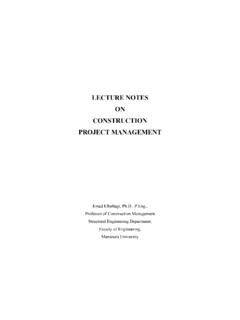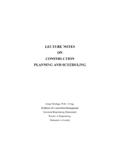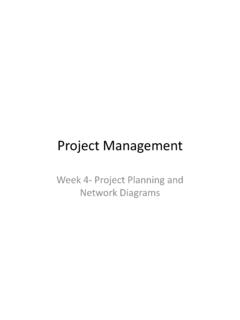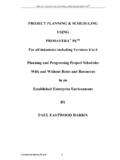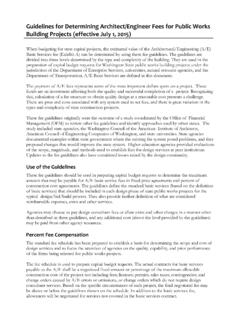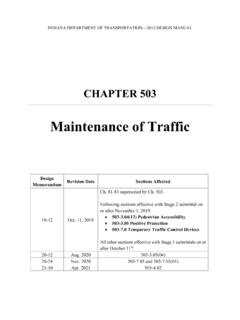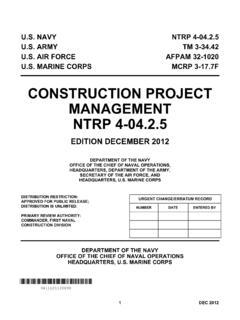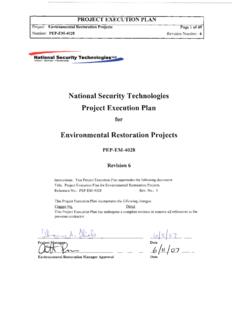Transcription of Excavation and Embankment (cut and fill)
1 Iv TOPICS Topic Page TOPIC I: Earthwork construction and Layout .. 1-27 TOPIC II: Estimating Quantities and Costs .. 28-52 TOPIC III: Scheduling .. 53-67 TOPIC IV: Material Quality Control and Production .. 68-72 TOPIC V: Temporary Structures .. 73-79 v TABLE OF CONTENTS How to Use This Guidebook .. i-vi construction Engineering Cheat Sheet .. vii-viii TOPIC I: Earthwork construction and Layout 1. Excavation and Embankment .. 3-11 2. Borrow Pit Volumes .. 12-20 3. Site Layout and Control .. 21-27 TOPIC II: Estimating Quantities and Costs 4. Quantity Take Off Method .. 30-43 5. Cost Estimating .. 44-52 TOPIC III: Scheduling 6.
2 construction Sequencing .. 55-58 7. Resource Scheduling .. 59-61 8. Time Cost Trade Off .. 62-67 TOPIC IV: Material Quality Control and Production 9. Material Testing .. 68-72 TOPIC V: Temporary Structures 10. construction Loads .. 73-79 vi READ FIRST: How to Use This Guidebook This guide for the construction AM Module and is intended to help walk you through studying for the Civil PE exam. You will find all of the study material needed for the AM construction portion of the exam. We have spent countless hours reviewing material from the Civil Engineering Reference Manual (CERM), the NCEES design standards, study guides, the internet, engineering textbooks to ensure that we have provided you with the most up-to-date and accurate resource available.
3 When you begin studying from this book use the following approach: 1. Print out e-book and place in 3 binder. Label the Binder construction Engineering and tab each chapter. 2. Make sure the construction engineering cheat sheet is in the front of the binder. Add to it as needed. 3. Once you complete each chapter, solve as many problems as you can that relate to the chapter you just covered. Do at least three problems from other sources. If you have any questions on a technique or a concept, ask the question at either or 4. Place those problems inside the construction binder behind the chapter and make a tab labeled Problems.
4 If you use another reference manual when solving problems, make sure to tab them as well. If you follow this approach, you will have solved multiple problems for every section and you will have all your references, notes pages, and problems fully tabbed so that you can easily reference them during the actual exam. To report errors in this text, write to construction ENGINEERING CHEAT SHEET vii Basic Conversions 1 cubic yard = 27 cubic feet 1 cubic foot of Water = gallons 1 gal of Water = lbs 1ft of Water = psi Ft Head = 1 psi pressure 5,280 Ft = 1 Mile 43,560 ft^2 = 1 Acre 1 Board Ft = 144 in^3 1,440 min / day 1 liter = 1 kg Basic Properties Density of Water = pounds per CF (pcf), 1,000 g/liter = 1,000kg/m3 Economic Haul Distance; Large Dozer up to 3000 ft; Scraper 3000 5000 ft.
5 Trucks > 5000 ft Density = Weight (lbs) / Volume (cf) Specific gravity = Density of material / Density of water Density of Water = lbs/cf or 1000 kg/cubic meter lbs of concrete/sack of cement = 94 lbs Earthwork construction and Layout Excavation and Embankment General Trapezoidal Formula: Area = (h0/2 + h1 + h2 + ..+ h(n-1) + hn/2) x w Average end area Method = V = ((A1+A2)/2) * L Pyramid Method = V = AL / 3 Borrow Pit Volumes Conical Spoil Pile = Vol = (Ab x H) / 3; D = ( / tan )1/3; H = (D/2) tan ; where Ab=base area; H=pile height;D=diameter; = angle of repose (deg) Triangular Spoil Bank = Vol = Cross section Area x L ; B = (4V/(L x tan )1/3 ; H = (B x tan ) / 2 ; V= pile volume; B= base width ; H = pile ht; L = pile length.)
6 = angle of repose (deg) Density of Water = water = Mw/Vw Moisture Content (w) = Mw/Ms Degree of Saturation (S) = Vw/Vv Total or Wet Density of Soil ( wet) = M/V where M = Mw + Ms ; V = Vw + Vs + Va Density of Solids = Ms/Vs Specific Gravity = Gs = solids / water ; or = Ms/(Vs * water ) Porosity (n) = Vv/Vt ; Vv = Volume of Voids = Vw + Va ; Vt = Total Volume = Vs +Vw + Va Void Ratio (e) = Vv/Vs Dry Density of Soil ( dry) = Ms /V Dry Density of Soil ( dry) = wet / (1+w); ( dry) = ( water*Gs) / (1+(w/S)*Gs) ( dry) = ( water * Gs)/(1+e) Specific Gravity = S * e = Gs * w Porosity (n) = e/(1+e) Void Ratio (e) = n/(1-n) VCompacted = VBanked (1 SHRINKAGE) VLoose = VBanked (1+SWELL) EARTHWORK construction AND LAYOUT TOPIC I 1 TOPIC I: Earthwork construction and Layout Chapter Page Introduction.
7 2 1. Excavation and Embankment .. 3-11 2. Borrow Pit Volumes .. 12-20 3. Site Layout and Control .. 21-27 EARTHWORK construction AND LAYOUT TOPIC I 2 Earthwork construction and Layout Introduction The earthwork section is the typical starting point anyone starting to prepare for the construction portion of the Civil PE Exam. The Earthwork section is a critical to know and there will be at least 3 questions on the exam directly covering these concepts. This topic covers three sections. Section 1: Excavation and Embankment : This section deals with the removal and/or addition of soil to the existing terrain.
8 Section 2: Borrow Pit Volumes: There is some overlap with the section 1 and this section but this deals with taking soil from an existing location. The soil properties, volumes, and water content are known and you have to figure out how to solve for relevant information. Section 3: Site Layout and Control: This section is for basic information on surveying and site preparation. The Earthwork construction and Layout topic area is very important and is the most difficult part of the construction AM portion. When studying this topic stay focused and make sure to master all the concepts and formulas. If you use common sense, deductive reasoning, and have the ability to deal with the question in a calm state of mind, you should be able to navigate this section and capitalize on these critical and necessary points.
9 There is an incredible amount of information out there discussing the Earthwork topics that can be found in the CERM, Goswani, and Ruwan. Also, internet searches typically render Power Point slides from various universities around the country discussing Earthwork. We have gone through most, if not all, of the above referenced materials and the goal here is to bring to you the pertinent information, the MUST KNOW information, regarding this topic for the exam. EARTHWORK construction AND LAYOUT TOPIC I 3 1 Excavation and Embankment Introduction This section is the longest and is consider the most difficult topic area for the AM section of the construction Engineering material.
10 It is by no means impossible to learn, or really that difficult I just point that out so you do not get discouraged with this section and you bare down and focus on learning and mastering this section. Even though the NCEES syllabus states there will only be 1-2 questions on this topic there are other area that could use some of the concepts here to answer those questions too, for example in cost estimating they might need to know how much it will cost per truck load. To solve for that you need to be able to figure out how much soil needs to be hauled. This topic will cover the following concepts.

